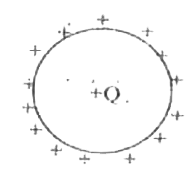A charged body has an electric flux F assoclated with it. Now if the body is placed inside a conducting shell tthen the electric flux outside the shell is
Zero
Greater then F
Less then F
Equal to F
The correct Answer is:D
To solve the problem, we need to understand the concept of electric flux and how it behaves when a charged body is placed inside a conducting shell.
1. Understanding Electric Flux:
Electric flux (Φ) through a surface is defined as the product of the electric field (E) and the area (A) through which the field lines pass, mathematically given by:
Φ=E⋅A
It is also related to the charge (Q) enclosed by the surface through Gauss's Law:
Φ=Qencε0
where ε0 is the permittivity of free space.
2. Placing the Charged Body Inside a Conducting Shell:
When a charged body is placed inside a conducting shell, the electric field inside the conducting material of the shell becomes zero. This is due to the redistribution of charges on the surface of the conductor in response to the electric field created by the charged body.
3. Electric Field Inside the Shell:
The electric field inside the conducting shell (between the charged body and the shell) is zero. Therefore, the electric flux through any Gaussian surface that lies within the conducting material of the shell is also zero.
4. Electric Flux Outside the Shell:
According to Gauss's Law, the electric flux through a closed surface is proportional to the charge enclosed within that surface. Since the conducting shell does not allow any electric field lines from the charged body to escape outside, the total charge enclosed by any Gaussian surface outside the shell remains zero.
5. Conclusion:
Therefore, the electric flux outside the conducting shell is zero. This is a consequence of the electrostatic shielding effect of the conducting shell, which prevents the electric field from the charged body from affecting the space outside the shell.
Final Answer:
The electric flux outside the conducting shell is zero.
---
Electric flux (Φ) through a surface is defined as the product of the electric field (E) and the area (A) through which the field lines pass, mathematically given by:
Φ=E⋅A
It is also related to the charge (Q) enclosed by the surface through Gauss's Law:
Φ=Qencε0
where ε0 is the permittivity of free space.
When a charged body is placed inside a conducting shell, the electric field inside the conducting material of the shell becomes zero. This is due to the redistribution of charges on the surface of the conductor in response to the electric field created by the charged body.
The electric field inside the conducting shell (between the charged body and the shell) is zero. Therefore, the electric flux through any Gaussian surface that lies within the conducting material of the shell is also zero.
According to Gauss's Law, the electric flux through a closed surface is proportional to the charge enclosed within that surface. Since the conducting shell does not allow any electric field lines from the charged body to escape outside, the total charge enclosed by any Gaussian surface outside the shell remains zero.
Therefore, the electric flux outside the conducting shell is zero. This is a consequence of the electrostatic shielding effect of the conducting shell, which prevents the electric field from the charged body from affecting the space outside the shell.
The electric flux outside the conducting shell is zero.
Similar Questions
A charged body has an electric flux ϕ associated with it. The body is now placed inside a metallic container. The flux ϕ, outside the container will be
View SolutionTotal electric flux associated with unit positive charge in vacuum is
View Solutiona hemispherical hollow body is placed in a uniform electric field E. the total flux linked with the curved surface is
 View Solution
View SolutionA charge q is placed at the centre of a cube. What is the electric flux passing through the cube?
View SolutionA point charge +Q is placed at the centre of an isolated conducting shell of radius R. Find the electrostatic potential energy stored outside the spherical shell if the shell also contains charge +Q distributed uniformly over it.
 View Solution
View SolutionA charge q is placed at the centre of the open end of a cylindrical vessel . The flux of the electric field through the surface of the vessel is
 View Solution
View Solutiona hemispherical hollow body is placed in a uniform electric field E. the total flux linked with the curved surface is
 View Solution
View SolutionWhen a 10 μC charge is enclosed by a closed surface, the flux passing through the surface is ϕ. Now another 10 µC charge is placed inside the closed surface, then the flux passing through the surface is ______.
View SolutionCharge of 2 C is placed at the centre of a cube. What is the electric flux passing through one face ?
View SolutionIn the following question a statement of assertion (A) is followed by a statement of reason (R )
A: the potential difference between two concentric sphereical shells depends only on the charge of inner shell
R : the electric field in the region in between two shells depedns on the charge of inner shell and electric field is the negative of potential gradient.View Solution

